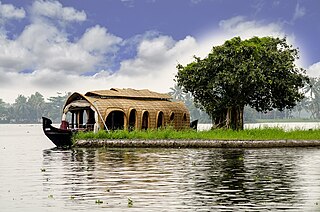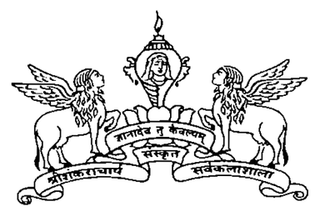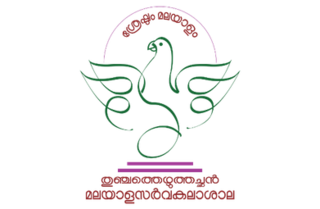
Malayalam is a Dravidian language spoken in the Indian state of Kerala and the union territories of Lakshadweep and Puducherry by the Malayali people. It is one of 22 scheduled languages of India. Malayalam was designated a "Classical Language of India" in 2013. Malayalam has official language status in Kerala, and Puducherry (Mahé), and is also the primary spoken language of Lakshadweep, and is spoken by 34 million people in India. Malayalam is also spoken by linguistic minorities in the neighbouring states; with a significant number of speakers in the Kodagu and Dakshina Kannada districts of Karnataka, and Kanyakumari, district of Tamil Nadu. It is also spoken by the Malayali Diaspora worldwide, especially in the Persian Gulf countries, due to the large populations of Malayali expatriates there. They are a significant population in each city in India including Mumbai, Bengaluru, Delhi, Kolkata, Pune etc.

A code talker was a person employed by the military during wartime to use a little-known language as a means of secret communication. The term is now usually associated with United States service members during the world wars who used their knowledge of Native American languages as a basis to transmit coded messages. In particular, there were approximately 400 to 500 Native Americans in the United States Marine Corps whose primary job was to transmit secret tactical messages. Code talkers transmitted messages over military telephone or radio communications nets using formally or informally developed codes built upon their native languages. The code talkers improved the speed of encryption and decryption of communications in front line operations during World War II.

Malayalam script is a Brahmic script used commonly to write Malayalam, which is the principal language of Kerala, India, spoken by 45 million people in the world. It is a Dravidian language spoken in the Indian state of Kerala and the union territories of Lakshadweep and Puducherry by the Malayali people. It is one of 22 scheduled languages of India Malayalam script is also widely used for writing Sanskrit texts in Kerala.

Malayalam, the lingua franca of the Indian state of Kerala and the union territories of Lakshadweep and Puduchery, is one of the six Classical languages of India. Malayalam literature comprises those literary texts written in Malayalam, a South-Dravidian language spoken in the Indian state of Kerala. The first travelogue in any Indian language is the Malayalam Varthamanappusthakam, written by Paremmakkal Thoma Kathanar in 1785. Malayalam literature has been presented with 6 Jnanapith awards, the second-most for any Dravidian language and the third-highest for any Indian language.

Tulu is a Dravidian language whose speakers are concentrated in Dakshina Kannada and the southern part of Udupi of Karnataka in south-western India and in the northern parts of the Kasaragod district of Kerala. The native speakers of Tulu are referred to as Tuluva or Tulu people and the geographical area is unofficially called Tulu Nadu.

Languages spoken in the Republic of India belong to several language families, the major ones being the Indo-Aryan languages spoken by 78.05% of Indians and the Dravidian languages spoken by 19.64% of Indians, both families together are sometimes known as Indic languages. Languages spoken by the remaining 2.31% of the population belong to the Austroasiatic, Sino–Tibetan, Tai–Kadai, and a few other minor language families and isolates. As per the People's Linguistic Survey of India, India has the second highest number of languages (780), after Papua New Guinea (840). Ethnologue lists a lower number of 456.
The Malayali people are a Dravidian ethnolinguistic group originating from the present-day state of Kerala in India, occupying its southwestern Malabar coast. They are predominantly native speakers of the Malayalam language, one of the six Classical languages in India. The state of Kerala was created in 1956 through the States Reorganisation Act. Prior to that, since the 1800s existed the Kingdom of Cochin, the Kingdom of Travancore, Malabar District, and South Canara of the British India. The Malabar District was annexed by the British through the Third Mysore War (1790–92) from Tipu Sultan. Before that, the Malabar District was under various kingdoms including the Zamorins of Calicut, Kingdom of Tanur, Arakkal kingdom, Kolathunadu, Valluvanad, and Palakkad Rajas.

Hermann Gundert was a German missionary, scholar, and linguist, as well as the maternal grandfather of German novelist and Nobel laureate Hermann Hesse. Gundert is chiefly known for his contributions as an Indologist, and compiled a Malayalam grammar book, Malayalabhaasha Vyakaranam (1859), in which he developed and constricted the grammar spoken by the Malayalis, nowadays; a Malayalam-English dictionary (1872), and contributed to work on Bible translations into Malayalam. He worked primarily at Tellicherry on the Malabar coast, in present day Kerala, India. Gundert also contributed to the fields of history, geography and astronomy.

Judeo-Malayalam is the traditional language of the Cochin Jews, from Kerala, in southern India, spoken today by a few dozens of people in Israel and by probably fewer than 25 in India.

The culture of Kerala has developed over the past millennia, influences from other parts of India and abroad. It is defined by its antiquity and the organic continuity sustained by the Malayali people. Modern Kerala society took shape owing to migrations from different parts of India and abroad throughout Classical Antiquity.

Kerala is a state on the Malabar Coast of India. It was formed on 1 November 1956, following the passage of the States Reorganisation Act, by combining Malayalam-speaking regions of the erstwhile regions of Cochin, Malabar, South Canara, and Thiruvithamkoor. Spread over 38,863 km2 (15,005 sq mi), Kerala is the 21st largest Indian state by area. It is bordered by Karnataka to the north and northeast, Tamil Nadu to the east and south, and the Lakshadweep Sea to the west. With 33 million inhabitants as per the 2011 census, Kerala is the 13th-largest Indian state by population. It is divided into 14 districts with the capital being Thiruvananthapuram. Malayalam is the most widely spoken language and is also the official language of the state.
Vatteluttu, popularly romanised as Vattezhuthu, was a syllabic alphabet of south India and Sri Lanka used for writing the Tamil and Malayalam languages.

George Varghese Kakkanadan, commonly known as Kakkanadan, was an Indian short-story writer and novelist in the Malayalam language. His works broke away from the neo-realism that dominated Malayalam literature through the 1950s and 1960s. He is often credited with laying the foundation of modernism in Malayalam literature. He is a recipient of Kendra Sahitya Akademi Award and Kerala Sahitya Akademi Awards in addition to numerous other awards and recognitions.

The population of Kerala, India is a heterogenous group that comprises many ethnic groups that originated in other parts of India as well as the world, with distinctive cultural and religious traditions. While the majority of Keralites speak the Malayalam language, various ethnic groups may speak other languages as well.

The Sree Sankaracharya University of Sanskrit (SSUS) is a Sanskrit university in India established in 1993 in Kalady, Kerala. It provides education in Sanskrit, other Indian and Foreign languages, Social science and fine arts. It is accredited A+ by National Assessment and Accreditation Council (NAAC). The university has eight regional campuses across Kerala.
Mūlabhadra (മൂലഭദ്ര) aka Mūlabhadri was a secret method of communication employed by the royal spies of the erstwhile Travancore Kingdom during the medieval period. The scheme was also colloquially referred to as Mūlapatra. It was essentially a cryptographic scheme involving a partial transposition of the letters of the Malayalam alphabet. The scheme had been extensively used by King Marthanda Varma (1706–1758) of Travancore Kingdom and his spies both for oral and written communication of messages. It was a fixed one-time unchangeable code in as much as it did not employ any key in its implementation in contrast to modern methods of substitution ciphers involving the utilisation of a key for generating a system of codes. Mūlabhadra is the only such scheme known to have been used in governance in this part of India during this period.The only known speaker of the language currently is K. N. Mohan, Ettumanoor, Kottayam district, Kerala.

Thunchath Ezhuthachan Malayalam University, also called Malayalam University, is a state university in Tirur, Kerala, India.
Beary or Byari is a Dravidian language spoken by the Muslim communities mainly of Karnataka and extreme northern end of Kerala like Manjeshwaram, Kunjathur, Uppala, Hosangadi of Kasaragod district (Byaris). Bearys speak a language made of Malayalam idioms with Tulu phonology and grammar. This language is traditionally known as Mappila Bashe because of Bearys' close contact with Mappila, the Malayali Muslims. Due to the intensive influence of Tulu for centuries, it is today considered close to both Tulu and Malayalam.
Suriyani Malayalam, also known as Karshoni, Syro-Malabarica or Syriac Malayalam, is a dialect of Malayalam written in a variant form of the Syriac alphabet which was popular among the Saint Thomas Christians of Kerala in India. It uses Malayalam grammar, the Maḏnḥāyā or "Eastern" Syriac script with special orthographic features, and vocabulary from Malayalam and East Syriac. This originated in the South Indian region of the Malabar Coast. Until the 19th century, the script was widely used by Syrian Christians in Kerala.

Kerala Infrastructure and Technology for Education (KITE) is a state owned special purpose company under Department of General Education of the Government of Kerala. It was developed to support ICT enabled education for schools in Kerala. The erstwhile IT@School Project was transformed into KITE for extending its scope of operations in August 2017. KITE was the first SPV company to get funded by KIIFB.














